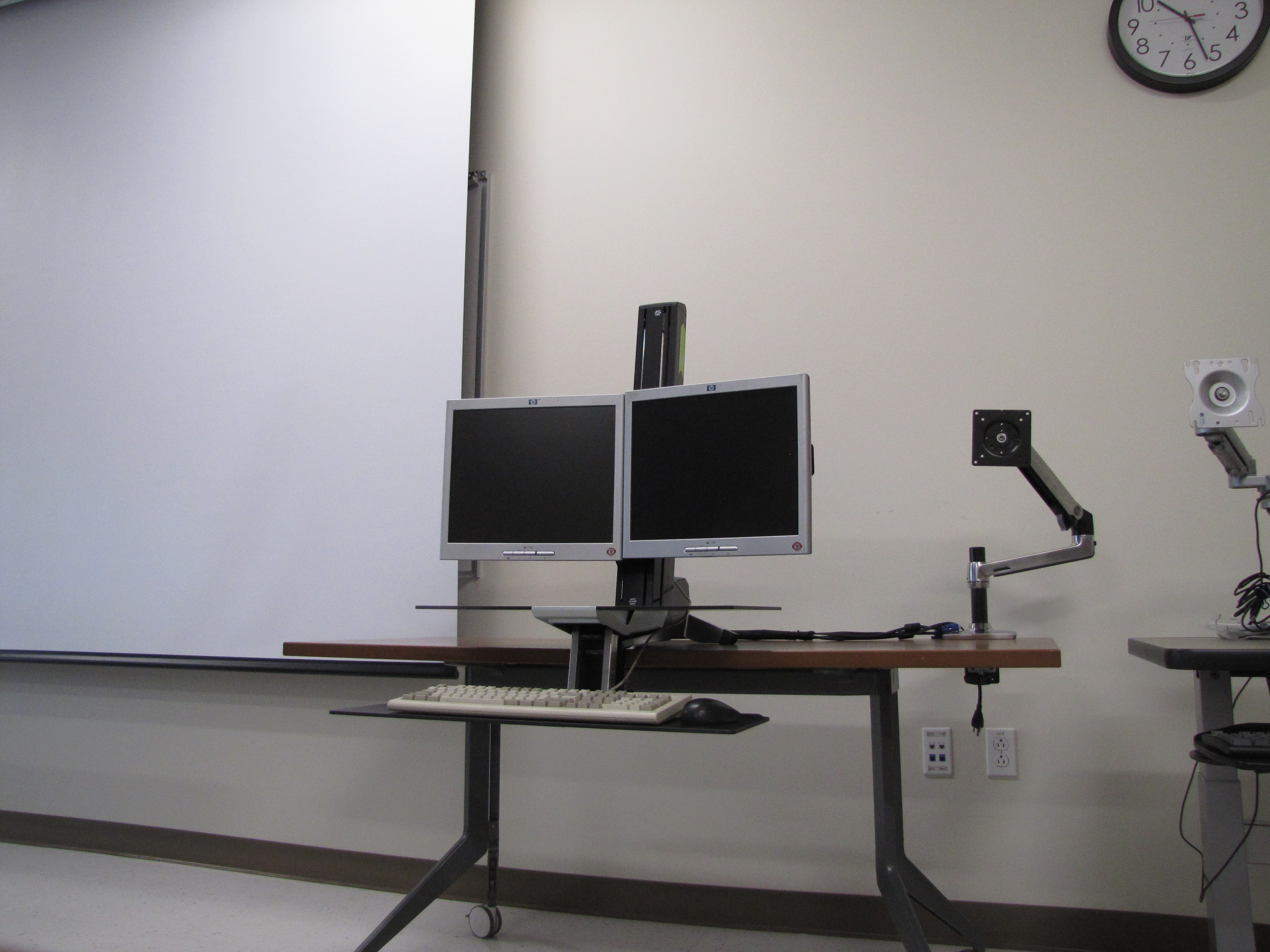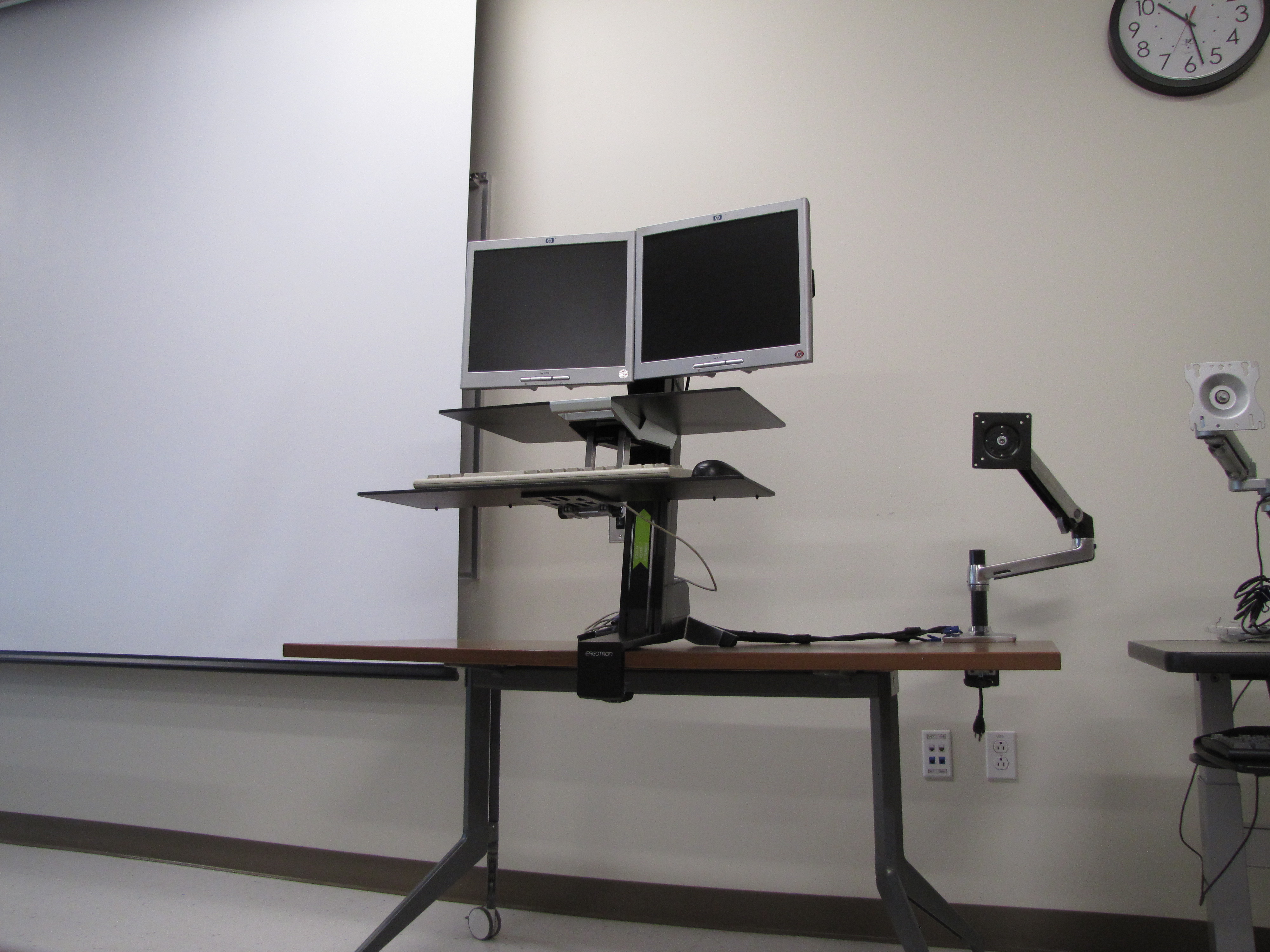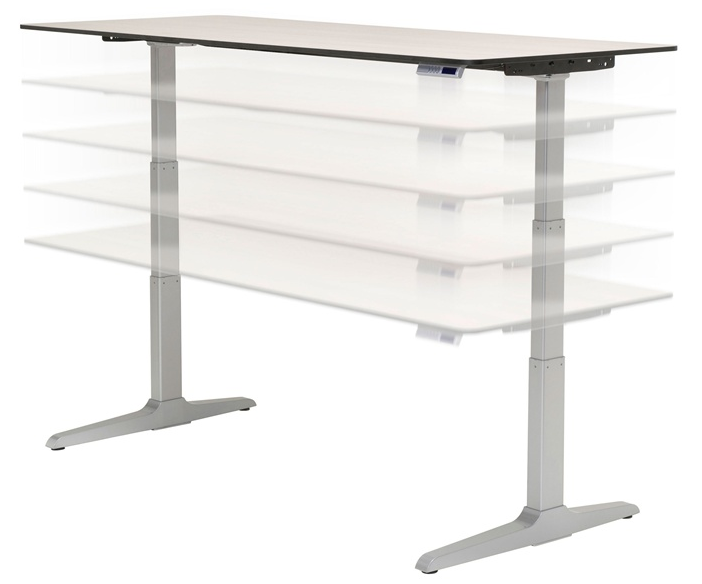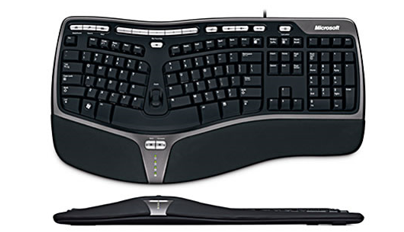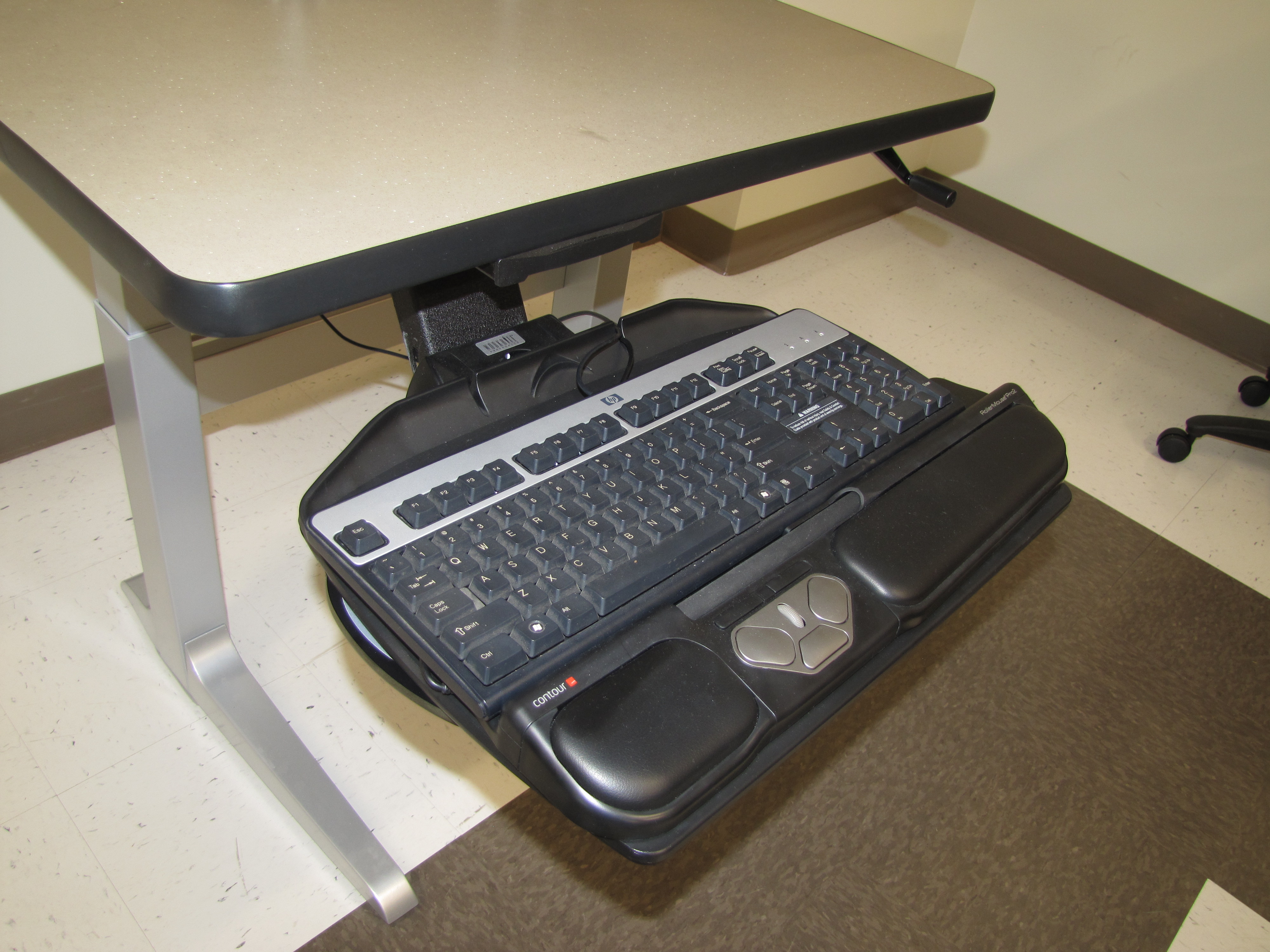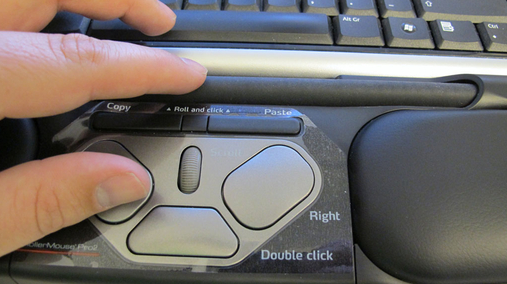Cal State LA’s Ergonomics Program promotes employee health by limiting ergonomic risk factors. The links below provide educational information on the basics of ergonomics for employees to self-assess and avoid injury while at work when working at home or to help friends and coworkers who may have similar issues.
Ergonomics is the science of fitting the work environment to the employee. Ergonomic assessments and training are designed to analyze and evaluate an employee’s workspace, equipment, body mechanics, posture, and workflow to promote a more efficient and productive worker. Proper ergonomic design is necessary to make a job the most comfortable for the individual performing it to reduce the risk of developing a musculoskeletal disorder (MSD). MSDs are conditions that can develop over time, causing pain or injury to muscles, nerves, tendons, and joints.
You can become ergonomic conscious and reduce your chance of developing MSDs by knowing the risk factors:
- Repetition
- Static or awkward postures or positions: the same position being held for a long period of time
- Stress or pressure on a joint
- Force
Neutral posture is a comfortable body position in which your joints are aligned. Working with a neutral body posture reduces muscle strain and stress.
If you would like to request an ergonomic evaluation, please complete and submit the Ergonomic Evaluation Request Form.
For further ergonomic related questions, contact the Risk Management - Environmental, Health, and Safety (RMEHS) Department.
Ergonomic Chair Checklist
Things to Consider
- Chair has wheels or castors suitable for the floor space
- Chair swivels
- Backrest is adjustable for height and angle
- Backrest supports the inward curve of the lower back
- Chair height is appropriate for the individual and the work surface height
- Chair is adjusted so there is no pressure on the backs of the legs, and feet are flat on the floor or on a foot rest
- Chair is adjustable from the sitting position
- Chair upholstery is a breathable fabric
- Footrests are used if feet do not rest flat on the floor
Features of an Ergonomic Chair
In order to help make sure you choose a chair with all the necessary adjustments, we will break the chair down into components:
- Casters and Base - Use a chair with casters and a 5-point base to ease movement and minimize possible tipping. Generally, nylon carpet casters are standard, but soft wheel casters are available for hard surfaces such as linoleum. Rubber locking casters are useful on stools to prevent tipping.
- Seat Pan - The seat pan is the component of the chair that supports the majority of the user’s weight. It is important to purchase a chair which uses dense, small-cell foam padding or spring coils to retain its support and cushioning (this usually involves purchasing a chair over $350.00). The front part of the seat should slope down slightly (waterfall design) and allow a fist size gap between the back of the knees and the front edge of the seat pan to reduce pressure at the back of the thighs. Tilt adjustments are preferred to allow a slight forward or reclined working posture to be attained. A seat pan with a sliding mechanism is also a beneficial feature. This allows small and tall users to adjust the distance from the back rest.
- Backrest - Adequate lumbar support is the most crucial element of a backrest. The backrest should either be small enough to fit into the small of the back, clearing the pelvis and back of the rib cage, or curved to provide adequate support. Many chairs come with a built-in lumbar adjustment which can be adjusted by turning a knob on the back of the chair and then raising the backrest to a comfortable position. Inadequate lumbar support places excess pressure on the spine. Remember, a lumbar support cushion properly placed with the fullest part of the support behind the small of the back (belt-line) can help to accentuate lumbar support. The backrest should also have angle, in-out, and height adjustments to achieve proper spinal alignment. The angle adjustment allows the user to adjust the angle of the back rest relative to the seat pan, as opposed to the tilt mechanism, which moves the seat pan with the backrest. When you change the tilt, the angle between the seat pan and the backrest stays the same.
- Armrests - Height and width adjustments are absolutely necessary when purchasing a chair with armrests. The armrest should be made of a soft material and should be at least 2" wide to provide adequate surface area.
- Seat Height - Almost all task chairs come with a hydraulic seat height adjustment. This is probably the single most important adjustment mechanism on a chair. It allows the user to adjust the chair so their feet can rest properly on the floor or footrest and the upper body is properly aligned with the computer monitor and input devices such as the keyboard and mouse.
- Chair Recline or Tilt - The chairs recline or tilt adjustment changes the angle of the entire seat relative to the floor. As with backrest angle adjustability, a reclined chair transfers some of the upper body weight to the backrest of the chair. It is also important that the user change body positioning throughout the day.
It is always important to try out or “test-drive” a chair before you purchase a chair in order to determine individual comfort.
See how to adjust your ergonomic chair within the workstation environment.
Eye Comfort Exercises
- Blinking - produces tears to help moisten and lubricate the eyes.
- Yawning - produces tears to help moisten and lubricate the eyes.
- Expose the eyes to natural light.
- Periodically focus on objects at least 20 feet away.
- Palming
- While seated, brace elbows on the desk and close to the desk edge
- Let weight fall forward
- Cup hands over eyes
- Close eyes
- Inhale slowly through nose and hold for 4 seconds
- Continue deep breathing for 15-30 seconds
- Eye Movements
- Close eyes
- Slowly and gently move eyes up to the ceiling, then slowly down to the floor
- Repeat 3 times
- Close eyes
- Slowly and gently move eyes to the left, then slowly to the right
- Repeat 3 times
- Focus Change
- Hold one finger a few inches away from the eye
- Focus on the finger
- Slowly move the finger away
- Focus far into the distance and then back to the finger
- Slowly bring the finger back to within a few inches of the eye
- Focus on something more than 8 feet away
- Repeat 3 times
Musculoskeletal Exercises
- Deep Breathing
- While standing, or in an otherwise relaxed position
- Place one hand on the abdomen and one on the chest
- Inhale slowly through the nose
- Hold for 4 seconds
- Exhale slowly through the mouth
- Repeat
- Cable Stretch
- While sitting with chin in, stomach in, shoulders relaxed, hands relaxed in lap, and feet flat on the floor, imagine a cable pulling the head upward
- Hold for 3 seconds and relax
- Repeat 3 times
- Sidebend: Neck Stretch
- Tilt head to one side (ear towards shoulder)
- Hold for 15 seconds
- Relax
- Repeat 3 times on each side
- Diagonal Neck Stretch
- Turn head slightly and then look down as if looking in your pocket
- Hold for 15 seconds
- Relax
- Repeat 3 times on each side
- Shoulder Shrug
- Slowly bring shoulders up to the ears and hold for approximately 3 seconds
- Rotate shoulders back and down
- Repeat 10 times
- Executive Stretch
- While sitting, lock hands behind head
- Bring elbows back as far as possible
- Inhale deeply while leaning back and stretching
- Hold for 20 seconds
- Exhale and relax
- Repeat
- Foot Rotation
- While sitting, slowly rotate each foot from the ankle
- Rotate 3 times in one direction, then 3 times in the opposite direction
- Relax
- Repeat
- Hand Shake
- While sitting, drop arms to the side
- Shake hands downward gently
- Repeat frequently
- Hand Massage (Note: Perform very gently!)
- Massage the inside and outside of the hand using the thumb and fingers
- Repeat frequently (including before beginning work)
- Finger Massage (Note: Perform very gently!)
- Massage fingers of each hand individually, slowly, and gently
- Move toward nail gently
- Massage space between fingers
- Perform daily
- Wrist Stretch
- Hold arm straight out in front of you
- Pull the hand backwards with the other hand, then pull downward
- Hold for 20 seconds
- Relax
- Repeat 3 times each
Pain Scale
When pain is present, it is your body’s way of telling you something is wrong. Remember, our activities are cumulative in each area of the body. If you are using your hands and arms in a repetitive activity at home – like painting or knitting – then type all day at work, you are at a greater risk of an ergonomic injury.
The following is a pain scale that is a guideline for how to treat the problem.
| Level of Pain | Description | Actions You Should Take |
|---|---|---|
| Minor | Doesn’t affect ability to do any activities. Pain is minor and is present only during an activity; not after. | Use this website to make sure your workstation is ergonomically correct and you are working in a neutral posture. |
| Moderate | Pain persistent enough to alter one’s behavior and performance. Residual discomfort after activity is completed. | Same as Minor. Seek ergonomic consultation if pain persists after changes are made or seek medical treatment. |
| Severe | Unable to do normal activities due to pain. | Seek medical treatment. Contact the RM/EHS Department ext 3-3531 |
If you experience recurrent, persistent or worsening discomfort, especially if the discomfort includes pain, numbness or weakness, promptly consult a qualified physician. The earlier a problem is correctly diagnosed and treated, the easier it is to take care of and less chance there is that it will progress to a disabling condition.
Evaluation Checklist
Desk/Workstation
- Do you have enough room on your work surface for all your computer accessories?
- Is your desk surface deep enough to provide at least 18" between your eyes and the computer screen?
- Are your most frequently accessed items (e.g., phone, manuals, etc.) easy to reach?
- If your desk has a fixed height, is the keyboard tray adjustable?
- Have you removed all under-desk obstructions?
- Do you have a document holder to hold paper for prolonged computer inputting?
- Do our arms rest on, or contact any sharp or square edges on your work surfaces?
- If a large percentage of your time involves using a phone do you use a phone headset?
- Is your source light out of your line of sight?
Chair
- Is your chair height adjustable?
- Is your chair back adjustable up and down?
- Is your chair back contoured to support the lower back?
- Is your backrest large enough to support your entire back, but not interfere with the use of your arms?
- Is your lumbar support a minimum of 12" wide?
- Is there room (2-4") between the front edge of the seat pan and the back of your knees?
- If your feet do not rest flat on the floor when your chair is properly adjusted, do you use a footrest?
- Is the top of your footrest covered with a non-skid material to reduce slippage?
- Do your chair arms interfere with you getting close to your work?
- Do your chair arms allow you to sit with your shoulders relaxed and not elevated?
- Does your chair have removable armrests?
- Is the distance between your armrests adjustable?
- Are your knees bent forming approximately a 90 degree or greater angle?
- Does the chair have a stable base supported by five legs with casters?
Monitor
- Is the viewing distance to your computer monitor somewhere between 18" - 30"?
- Is the top of your computer screen at or just below eye level?
- If you wear bifocals or trifocals, can you see the computer monitor without having to tilt your head back to read the screen or other items in your work area?
- Is your computer monitor free of glare or reflections?
- Is the monitor screen clean?
- Is character size easy to read?
- Do you have blinds on the windows near your computer?
- Do you use a glare screen to reduce glare on your monitor?
Keyboard
- With your chair adjusted properly is your work surface at approximately elbow level?
- Are your shoulders relaxed and not elevated when you work at your work surface?
- Is the height of your keyboard low enough so your arms are relaxed at your side?
- When you address your work surface to type or write is there approximately a 90 degree angle between your forearms and upper arms and are your elbows close to your body?
- When you address your work surface to type are your wrist in line with your forearms and not bent upwards, downwards, or side-to-side?
- Do you have a wrist rest to support your wrists in a straight and neutral position?
Mouse, Trackball, or Other Input Device
- Is your mouse, trackball, or other input device (i.e., touchpad, etc.) located directly in our immediate reach zone?
- Is your mouse or trackball positioned next to your keyboard?
- Is your mouse or trackball placed together with our keyboard on an adjustable work surface or tray?
- Is our mouse work surface stable?
- Is the mouse or trackball at the same level as your keyboard?
Work Habits
- Do you take short and frequent breaks every 20-30 minutes?
- Do you frequently change body positions while working?
- Do you provide your eyes with vision breaks every half hour?
- Are you free from experiencing any pain or discomfort while working?
When selecting ergonomic equipment reliability and warranty are our first concerns. Over the years the best products meet these two requirements. In addition the equipment must fit the user. Before making your choice call our office we are happy to assist.
There are several vendors to choose from when making you decision, the following are some that RMEH&S use.
Recommended Vendors
Workrite
1450 Technology Lane
Petaluma, CA 94954
1 (800) 959-9675
Staples
See your buyer for special CSU pricing
Global
12320 Bloomfield Ave, Unit A
Santa Fe Springs, CA 90670
1 (562) 484-9686
Ergonomic Comfort Solutions
1 (951) 277-1558
- Microsoft Keyboard Shortcuts
- Cornell University
- UCLA
- CSU Movement White Paper - Get Up and Move!
- Octane Seating - Comprehensive Ergonomic White Papers
- University of California at Santa Barbara Ergonomics
- National Institute of Environmental health and Safety
- Occupational health and Safety Administration E-Tool for Ergonomic Computer Workstations
- National Institute of Occupational Safety and Health(NIOSH) ergonomics resources
- Equity and Diversity Office for ADA Compliance
- Office for Students with Disability
- Risk Management
How to Design Your Work Station
- Correct work station height depends upon the user of a work station and upon the chair and other factors that interact with the user and table. The ideal is for the user to be able to sit at the work station with the keyboard in place and be able to easily maintain a 90-100 degree elbow angle and straight wrists while keying. The height of an adjustable keyboard support should adjust between 23" and 28" to accommodate most-but not all-users. 26" is a recommended compromise position while leg clearance must still be considered.
- Leg room: Knee spaces should allow a worker to feel uncrowned and to allow some changes of position even with the keyboard support lowered to the correct level for use. The knee space should be at least 30" wide by 19"deep by 27" high to comply with the requirements of the Americans with Disabilities Act. For those using a footrest, clearance must be calculated with the legs in place on the footrest. Likewise, depth of the "clearance envelope" for both legs and toes should be evaluated while the workstation user is in a normal working position at the work station (determined by the design of the seating system and the way the user sits). Drawers and support legs (for furniture) should not go where human legs need to fit.
- The work station top should be big enough to allow space not only for all computer-related necessary equipment, but also for paperwork, books, and other materials needed while working at the computer. Working with materials on chairs and at odd angles has the potential for neck and other body strain. Frequently used items should be kept close to avoid long reaches. A general recommendation is that the work area top should be at least as big as the standard office desk - 30 inches by 60 inches. A depth of at least 30 inches allows flexibility in use/reuse of the work area. Usable space may be maximized by good wire/cable management.
- Thickness of work surface: one inch
An alternative to problems stemming from hours of sitting at the many things we do in our life and also for some of the injuries requiring limited sitting is to use a sit-stand workstation. Desks can can be fitted with equipment which makes the monitor and keyboard is height adjustable. Alternatively the entire desk surface can be made height adjustable by motors that extend the leg supports. These devices provide new ways to vary workstation postures to increase bloodflow and provide additional motion. However, these sit-stand alternatives are not a substitute for periodic breaks. Two of these alternatives are shown below.
The work area should be large enough to accommodate you, allow the full range of motions involved in performing required tasks, and provide room for the equipment and materials that make up the workstation.
- Use a headset for lengthy or frequent telephone work.
- Place the items you use most frequently directly in front of you.
- Avoid overcrowding computer work areas.
Standard furniture cannot accommodate everyone’s needs. A taller person may need a one-time adjustment to have his or her work surface raised somewhat; a shorter person may need a footrest or other accessories. Adjustable furniture may be needed in situations where people share or use the same workstation.
- The desktop should be organized so that frequently used objects are close to the user to avoid excessive extended reaching.
- The work surface should have a matte finish to minimize glare or reflections.
- The area underneath the desk should always be clean/uncluttered to accommodate the user’s legs and allow for stretching.
- If a fixed-height desk is used, add a keyboard tray that adjusts vertically to provide added adjustability.
- A footrest should be used if, after adjusting the height of the chair, feet do not rest flat on the floor.
- Use a headset or speaker phone to avoid neck and shoulder discomfort if you use a phone frequently throughout the day.
- Place the phone on the side of your non-dominant hand (i.e., left side if right-handed, right side if left-handed)
- Position your desk lamp (if you use one) so that it illuminates source documents without causing either glare on the computer screen or direct illumination to your eyes.
- A document holder should be used if documents are referred to during keying. The document holder should:
- Be stable and adjustable (height, position, distance, and angle of view).
- Support your document on either side of the monitor.
- Be at the same distance from your eyes as the display screen to avoid frequent changes of focus and you should be able you to look from one to the other without moving your neck or back.
Contrary to popular belief, sitting, which most people believe is relaxing, is hard on the back. Sitting for long periods of time can cause increased pressure on the intervertebral discs — the spongy discs between the vertebras. Sitting is also hard on the feet and legs. Gravity tends to pool blood in the legs and feet and create a sluggish return to the heart.
The following recommendations can help increase comfort for computer users:
- "Dynamic sitting", don’t stay in one static position for extended periods of time.
- When performing daily tasks, alternate between sitting and standing or take small walking breaks throughout the day.
- The chair back should have a lumbar support.
- Adjust height of backrest to support the natural inward curve of the lower back.
- It may be useful to use a rolled towel, lumbar roll or cushion to support the low back.
- The angle of the back rest is subjective but the trunk and upper legs should form an angle between 90 to 115 degrees.
- Adjust height of chair so feet rest flat on floor
- Sit upright in the chair with the low back against the backrest and the shoulders touching the backrest.
- Thighs should be parallel to the floor and knees at about the same level as the hips.
- Back of knees should not come in direct contact with the edge of the seat pan. There should be 2-4 inches between the edge of the seat and the back of the knee
- Arm rests should be removable and the distance between the arm rests should be adjustable.
- Adjust height and/or width of armrests so they allow the user to rest arms at their sides and relax/drop their shoulders while keyboarding.
- Don’t use armrests to slouch. Also, chair arms should not noticeably elevate your shoulders or force you to move your arms away from your body to use them.
- Elbows and lower arms should rest lightly on armrests so as not to cause circulatory or nerve problems.
- Use a footrest when attempts to adjust your chair and the rest of the workstation fail to keep your feet on the ground.
- Ensure that you have some space (2-3") between the top of your thighs and the underside of your workstation.
- Have enough space under your work surface so that you can pull your self all the way up to the edge of the desk with room for your legs and knees to fit comfortably.
Once the chair and work surface height are properly adjusted, the computer monitor should be placed so the top of the screen is at or just below eye level when seated in an upright position. The following suggestions can help prevent the development of eye strain, neck pain and shoulder fatigue while using your computer workstation:
- Make sure the surface of the viewing screen is clean.
- Adjust brightness and contrast to optimum comfort.
- Position the monitor directly in front of the user to avoid excessive twisting of the neck.
- User must position the monitor at a comfortable viewing distance, approximately 18-30 inches from the user.
- Position monitors at right angles from windows to reduce glare. Close window blinds as needed to reduce glare from sunlight.
- Position monitors away from direct lighting which creates excessive glare or use a glare filter over the monitor to reduce glare.
- Adjust the monitor tilt so that ceiling lights do not reflect on your screen.
- If a document holder is used, it should be placed at approximately the same height as the monitor and at the same distance from the eyes to prevent frequent eye shifts between the monitor screen and reference materials.
- Get regular eye check-ups.
- Adjust as needed for larger screens. You may need to sit farther away and increase the font size to take full advantage of the larger screen.
Bifocal and trifocal wearers have to pay particular attention to the placement of their monitor. Wearers of bifocals and trifocals often unknowingly tilt their heads backwards so they can read the screen through the lower portion of their glasses. This can sometimes lead to neck, shoulder, and back discomfort. Potential solutions include either lowering the computer monitor or purchasing glasses designed specifically for working at the computer.
Many ergonomic problems associated with computer workstations occur in the shoulder, elbow, forearm, wrist, and hand. Continuous work on the computer may expose soft tissues in these areas to repetition, awkward postures, and forceful exertions, especially if the workstation is not set up properly.
The following adjustments should be made to your workstation to help prevent the development of an ergonomic problem in the upper extremities:
- First adjust your chair as mentioned above, then with your arms resting comfortably at your side, raise your forearms to form a 90 degree angle with your upper arms.
- Adjust keyboard height so shoulders can relax and allow arms to rest at sides. An articulating keyboard tray is often necessary to accommodate proper height and distance.
- Position the keyboard directly in front and be close to the user to avoid excessive extended reaching.
- Forearms parallel to the floor (approximately 90 degree angle at elbow).
- Mouse should be placed adjacent to keyboard and at the same height as the keyboard. Avoid extended and elevated reaching for keyboard and mouse. The back of the wrist should be kept flat (in a neutral position). Do not rest the hand on the mouse when your are not using it. Rest hands in your lap when not entering data.
- A padded wrist rest will help to keep your wrist in a straight and neutral position while typing and keep your arms off the sharp edges of the work surface.
- Do not rest your wrists or hands on a palm or wrist rest when you are keying. These rests are designed to provide support only during breaks from keying.
- The slope of the keyboard may need to be adjusted so that it is flat in order that your wrists are straight, and not bent back while you are typing.
- Press the keys gently; do not bang them or hold them down for long periods. Keep your shoulders, arms, hands, and fingers relaxed.
If your work surface is too high and not adjustable, adjust your chair to bring your arms to the proper position. If you raise your chair make sure your feet are properly supported.
There are keyboard modifications which provide additional comfort. One excellent design, the Microsoft Ergonomic Keyboard, addresses both wrist angle and wrist rotation problems. Shown below.
- The mouse is present in virtually every office environment. Handed versions of mouses are designed specifically to the contours of either the right or left hand.
- Placing the mouse, trackball, or other input device too far away, too low, or too much on one side can cause shoulder, wrist, elbow, and forearm discomfort. Placing the input device directly in your immediate reach zone offers natural comfort and maximum hand-to-eye coordination.
- Do not bend your wrist upward. Make sure you are sitting high enough for the workstation to be slightly below elbow height so that your hand rests naturally on the mouse.
- Mousing demands a certain level of surface stability; if used on a keyboard tray, the tray should not wobble or tip.
- A trackball has an exposed ball that you manipulate with your fingers. It requires the use of different muscle and tendon groups than does a mouse, and can add variety to your manipulation of computer information. Some trackball designs, however, may cause discomfort and possible injury to the area around your thumb, which stretches and reaches to maneuver the trackball.
- Test different models of mousing devices, trackball or other input devices. Consider the shape and size of the devices, how comfortably it fits into your hand, ease of operation, and any special features that might make your job easier.
In addition to the mouse and trackball, a variety of other input devices are available. Consider your task requirements and physical limitations.
- RollerMouse Pro2 allows for very easy precision control of the cursor.. A light finger touch is all that is required. Shown here, note the index finger sliding/rolling the tube pointing device. Additional copy, paste, scroll and other convenient buttons are shown.
- Touch pads allow you to move the cursor on the computer screen by simply gliding your finger across a small pad. Unlike mice, trackballs, and other pointing devices, touch pads have no moving parts to clog or break. However, precision and range of cursor motion require additional attention.
- Touch screens allow you to point directly at an object. They require little or no training, are faster than other pointing devices, and require no extra work surface. However, the disadvantages of touch screens include arm fatigue, smudges, optical interference, and increased glare.
- Voice input allows you to "talk" to your computer. Currently, such programs can understand and respond to natural speech delivered at rates of up to 160 words per minute.
- Pen-like devices use pressure, light, electromagnetic disruption, or radio frequencies to enter and manipulate information through contact with the computer screen or a horizontal pad. A pen pad requires about as much room on the work surface as does a mouse. If pen technology is used on a horizontal pad, a workstation must provide adequate non-glare lighting for both it and the computer screen.
Lighting not suited to working with a computer is a major contributing factor in visual discomforts including eyestrain, burning or itching eyes, and blurred or double vision.
The lighting in most office environments is too bright for optimal VDT screen viewing. The illumination may be reduced by removing 2 bulbs in a 4-bulb fluorescent fixture, removing the bulbs in every other fixture, or turning off overhead lights altogether. Supplemental desk lighting is better than overhead lighting for reading or printed copy.
Use the following recommendations to reduce eyestrain and eye fatigue:
- Close drapes/blinds to reduce glare.
- Adjust lighting to avoid glare on screen (light source should come at a 90 degree angle, with low watt lights rather than high).
- Avoid intense or uneven lighting in your field of vision.
- Place monitor at 90 degree angle to windows (where possible).
- Reduce overhead lighting (where possible).
- Use indirect or shielded lighting where possible.
- Walls should not be painted with a reflective finish.
- Use a glare screen or monitor shield to reduce glare from overhead lighting.
Repetitious static work (working at the computer) is very fatiguing on your upper extremities as well as your eyes. It is important that breaks from working at the computer be taken every 20 to 40 minutes in order for your body to rest and recover. Taking a short break (3 to 5 minutes) does not mean you have to stop working, other activities such as talking to a co-worker, making copies, filing, etc. could be done during breaks from typing.
It is also important to change positions periodically. Sitting in one position or leaning on your arms for an extended period of time can interfere with circulation.
NOTE: LAPTOP COMPUTERS ARE NOT RECOMMENDED AS PRIMARY COMPUTERS. IN THE OFFICE OR WHILE AT HOME, A DOCKING STATION IS RECOMMENDED TO PROVIDE ADJUSTABILITY WHICH WILL ENHANCE NEUTRAL POSTURES.
Computing
Maintaining neutral postures will reduce stress and strain to the musculoskeletal system.
- Incorporate mini-breaks every 20 to 30 minutes to break up repetition and static postures.
- Maintain a comfortable viewing distance from your screen; about 18-30 inches.
- Keep your head and neck in a neutral posture; avoid excessive neck flexion or rotation.
- Angle the screen so that it is perpendicular to your line of sight, if lighting permits.
- Position the keyboard at elbow height, and keep your wrists straight while keying. Experiment with table height, chair height and keyboard angle to maintain neutral wrist postures.
- Remember: if you raise your chair use a footrest to support your feet. When seated your hips should be slightly higher than your knees.
- If you are seated in a side chair or couch, use a pillow to support your arms while keying. This will help you maintain neutral arm, wrist, and hand postures.
- Attach an external mouse instead of using the small constricted touchpad or trackball.
- Clean the screen regularly using appropriate antistatic cleaning materials.
- The hands and wrists should be kept in a straight wrist posture when typing and should not be resting on a pal rest, table, or lap while typing. Wrist and palm rests are designed to provide support during breaks from typing.
Transporting the Computer
- Keep these ideas in mind while carrying your laptop from place to place:
- Eliminate unnecessary baggage from your briefcase, the less demand placed on the body the better.
- Carry your laptop in a case with a padded shoulder strap and handle. Frequently shift hands or shoulders to balance the load.
- Use a wheeled luggage cart when possible.
